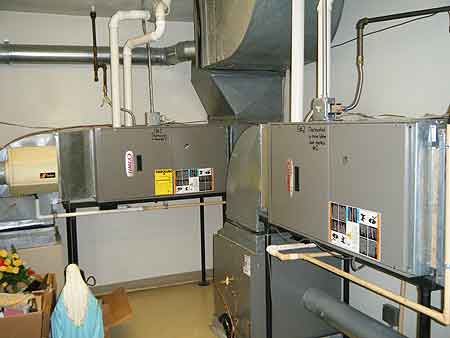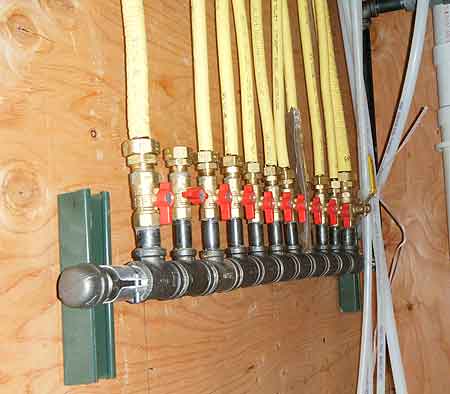Article and photos by Gregory Havel
When central heating became common in buildings in the early 20th century, there was usually one boiler or hot air furnace for the building or residence. The device was often located in the cellar or basement. Fuel (coal, wood, fuel oil, or gas) was brought to this one location in the building (and to the kitchen for the kitchen range). The fuel was converted to heat in the boiler or furnace and distributed to radiators by steam or hot-water pipes or to hot-air registers by ducts. Condensed steam and cooled water were returned to the boiler by pipes and cooled air to the furnace by return ducts. Fuel was inexpensive, and the heat lost in the pipes and ducts was not considered significant.
In warehouses and industrial buildings, where the need for heat was minimal or very local, unit heaters were often used. The fuel gas or oil was usually piped directly to these devices. Photo 1 shows a gas-fired unit heater suspended from the ceiling of a maintenance shop. The gas piping is black steel. The vent piping is galvanized steel. The power supply to the unit’s motor is the blue steel-jacketed cable. The low-voltage thermostat cable is white.

(1)
In the late 20th century, energy became expensive, tripling in price in a few years. Residences and other buildings became larger because of prosperity and changes in zoning regulations. The heat lost in pipes and ducts became a significant expense. To reduce operating costs, buildings began to be constructed with several smaller furnaces or boilers located throughout the building in closets, attics, and storage rooms, rather than one large unit in a furnace room. These smaller units had shorter runs of pipes and ducts to distribute heat, more efficient designs, and corresponding lower operating costs. However, this meant that fuel had to be piped throughout the building to the locations of heating appliances and water heaters. Photo 2 shows two modern high-efficiency furnaces installed in a closet. Natural gas piping is black steel with stainless steel flexible connectors. Combustion air intake and vent piping are large white polyvinyl chloride (PVC) pipe. Ducts are galvanized steel. Condensate drains from humidifiers, furnace combustion, and humidifiers are small PVC. (The residential building in which Photo 2 was taken is about 20,000 square feet (1,858 m3), and has 10 furnace units at six locations throughout the building.)

(2)
The fuel used in these buildings is usually natural gas or liquefied propane (LP) gas, although fuel oil is still common in some parts of North America. Fuel piping for gas is usually black steel pipe with threaded fittings or corrugated stainless steel tubing (CSST) with a yellow polyethylene jacket. Other materials may be acceptable to the authority having jurisdiction, depending on local codes and the corrosive impurities present in the natural gas. Fuel piping for oil is usually black steel pipe or red brass.
This change means that in large residences, apartment buildings, and hotels, fuel may be piped throughout the building instead of being limited to the boiler or furnace room and kitchen. Fuel piping can be inside walls or floor-ceiling assemblies, buried below concrete floors, or can be exposed in utility spaces.
The presence of fuel pipes throughout a building is significant for firefighters. No longer can we become complacent because the fire does not involve the kitchen or furnace room. Heating appliances can be anywhere in the building or apartment, as can the fuel pipes that feed them.
Even if the fuel piping and fittings are installed according to code, in assemblies tested and listed by Underwriters Laboratories (UL) or another independent laboratory, exposure to the heat of a fire can cause them to deteriorate and leak; the control valves at the appliances may also fail and leak. Any room-and- contents fire can become a fuel-fed fire or the ignition source and cause the ignition or explosion of leaking fuel a distance away. Building and fire codes usually incorporate by reference these National Fire Protection Association (NFPA) codes and standards:
- NFPA Standard 30, Flammable and Combustible Liquids Code, 2012 edition
- NFPA Standard 31, Installation of Oil-Burning Equipment, 2012 edition
- NFPA Standard 54, National Fuel Gas Code, 2012 edition
- NFPA Standard 58, Liquefied Petroleum Gas Code, 2011 edition.
Impact from firefighter overhaul tools can cause leaks in fuel pipes even if the pipes are properly installed.
Firefighters should be seriously concerned with fires in locations with fuel-burning appliances or in which fuel piping is exposed or damaged by overhaul. Fuel to these locations must be shut off at a distribution manifold away from the fire area or at the meter or storage tank. The utility company or fuel supplier and the owner’s heating appliance service contractor must be notified. These appliances and piping must not be returned to service until they have been inspected and tested by qualified persons and repaired or replaced if needed.

(3)
Photo 3 shows a natural gas distribution manifold in a residential building, inside the wall near the gas meter. The black steel pipe at the rear of the photo is the main from the gas company meter. Above the manifold, each branch line of CSST has a valve so that it can be turned off independently of the others.
Download this article as a PDF HERE.
REFERENCE
NFPA Standard 1:
- Oil: 11.5.1.1 and NFPA 31 Chapter 8
- Gas: 11.5.1.4 and NFPA 54; Chapter 5 (poly underground)
- LP: NFPA 1:69; and NFPA 58: 5.8 and 5.9 Pipe as NFPA 54, including copper, plastic, and aluminum; as approved by ASTM spec for LP gas service
MORE GREG HAVEL
- Construction Concerns for Firefighters: Package Heat Pumps
- Construction Concerns for Firefighters: Concealed Combustibles
- Construction Concerns for Firefighters: Buildings and Building Codes
 Gregory Havel is a member of the Town of Burlington (WI) Fire Department; retired deputy chief and training officer; and a 30-year veteran of the fire service. He is a Wisconsin-certified fire instructor II, fire officer II, and fire inspector; an adjunct instructor in fire service programs at Gateway Technical College; and safety director for Scherrer Construction Co., Inc. Havel has a bachelor’s degree from St. Norbert College; has more than 30 years of experience in facilities management and building construction; and has presented classes at FDIC.
Gregory Havel is a member of the Town of Burlington (WI) Fire Department; retired deputy chief and training officer; and a 30-year veteran of the fire service. He is a Wisconsin-certified fire instructor II, fire officer II, and fire inspector; an adjunct instructor in fire service programs at Gateway Technical College; and safety director for Scherrer Construction Co., Inc. Havel has a bachelor’s degree from St. Norbert College; has more than 30 years of experience in facilities management and building construction; and has presented classes at FDIC.

